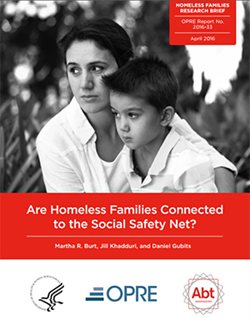Research Brief: Are Homeless Families Connected to the Social Safety Net?
More than 150,000 families in the United States experience homelessness each year. A new research brief explores whether these families are connected to the benefits and services of the social safety net.

Jill Khadduri, and Daniel Gubits of Abt Global joined consultant Martha R. Burt to examine participation among families experiencing homelessness in social safety net programs such as Temporary Assistance for Needy Families (TANF) cash assistance, the Supplemental Nutrition Assistance program (SNAP), and publicly funded health insurance programs. They found that while participation rates varied by program, homeless families in the sample reported rates of participation in social safety net programs greater than or equal to those of other deeply poor families.
The brief is the first in a series of research briefs commissioned by the Department of Health and Human Services that draw on the Family Options Study to inform HHS and HHS grantees about strategies for preventing and ending the homelessness of families, children, and youth. Other briefs in the series will include the well-being of adolescents who are homeless with their families, patterns of homelessness among Hispanic families, and young children’s experiences with homelessness and early care and education.
The research is based on data collected for the Family Options Study, sponsored by the U.S. Department of Housing and Urban Development and led by Abt Global. The study involved 2,282 homeless families with children who entered a homeless shelter between late 2010 and early 2012 in one of 12 communities across the United States.
The researchers note that while these findings show that homeless families tend to receive benefits at similar or higher rates than other families in deep poverty, more can still be done to connect them to benefits, as well as access to early education and center-based child care.
“These findings also suggest that, while additional efforts to connect families with poverty-level incomes to benefits as they now exist may be appropriate, they are not likely to be sufficient to prevent homelessness. Policymakers should also explore options for modifying how benefits and services operate for families in deep poverty and with repeated episodes of homelessness,” the researchers conclude.
Read the full brief.
